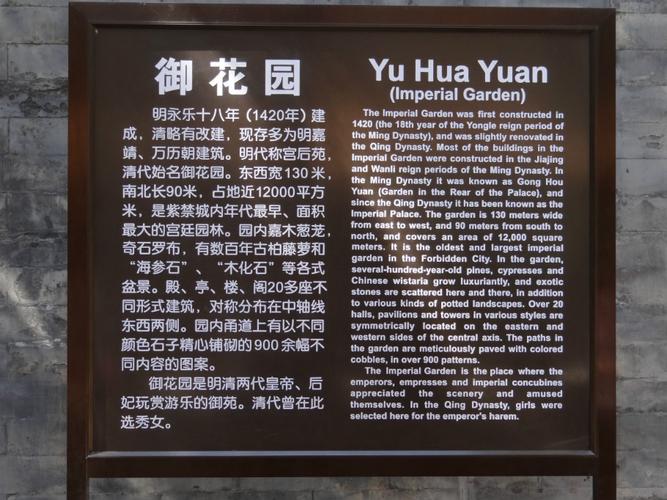
The Imperial Garden: A Haven for Relaxation and Recreation in the Forbidden City
A Sanctuary for Imperial Women
Nestled within the sprawling complex of the Forbidden City, the Imperial Garden served as a serene retreat for the emperor's consorts. It was a place where imperial women could escape the confines of palace life and enjoy moments of leisure and tranquility. This meticulously designed oasis offered a harmonious blend of natural beauty and architectural splendor, providing solace and entertainment for the esteemed residents of the inner court.
Location and Historical Significance
The Imperial Garden occupies a prime location within the Forbidden City, situated directly behind the Palace of Earthly Tranquility (Kunning Gong) and forming a central axis with the most significant structures of the complex. Originally known as the "Palace Rear Garden" (Gong Hou Yuan) during the Ming Dynasty, it was later renamed the "Imperial Garden" (Yu Hua Yuan) during the Qing Dynasty. The garden underwent several renovations and expansions under the reign of successive emperors, each adding their own distinctive touch to its layout and design. However, the core structure and essence of the garden remain largely unchanged, offering a glimpse into the aesthetic sensibilities of its imperial patrons.
A Landscape of Enchantment
Stepping into the Imperial Garden was akin to entering a realm of enchantment. Towering pines and cypresses stood as sentinels, their verdant canopies providing welcome shade from the sun. Gracefully sculpted rockeries, reminiscent of miniature mountains, punctuated the landscape, each bearing a unique character and history. The air hummed with the gentle murmur of trickling water, flowing from intricately carved fountains and meandering streams, further enhancing the garden's serene ambiance. The abundance of blossoming flowers, carefully cultivated to ensure a vibrant display throughout the seasons, filled the air with intoxicating fragrances, transforming the garden into a sensory delight.
Palaces of Respite
Strategically positioned around the perimeter of the Imperial Garden were numerous exquisitely crafted palaces, each offering panoramic views of the surrounding beauty. These structures served as elegant pavilions where the empress and consorts could rest and refresh themselves during their leisurely strolls through the garden. Here, they could enjoy refreshments, engage in conversation, or simply immerse themselves in the tranquil ambiance. These well-preserved palaces, with their intricate carvings and ornate decorations, stand as testaments to the opulence and grandeur that characterized imperial life within the Forbidden City.
Q&A
Q1: What was the primary purpose of the Imperial Garden?
A1: The Imperial Garden primarily served as a private retreat for the emperor's wives and concubines, offering a space for relaxation, recreation, and socializing within the confines of the Forbidden City.
Q2: What are some of the notable features of the Imperial Garden's landscape design?
A2: The Imperial Garden features a harmonious blend of natural elements and man-made structures, including meticulously sculpted rockeries, towering pine and cypress trees, meandering streams and fountains, and an abundance of colorful flowers.
Q3: How did the surrounding palaces enhance the functionality of the Imperial Garden?
A3: The palaces surrounding the Imperial Garden provided convenient resting spots for the imperial women, allowing them to take breaks during their walks, enjoy refreshments, and appreciate the surrounding scenery from different vantage points.